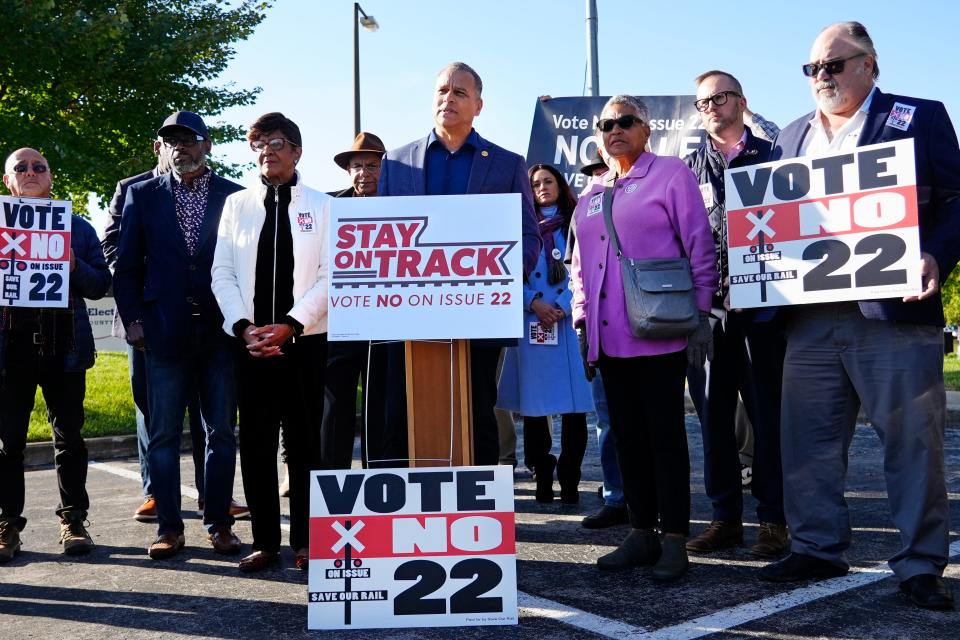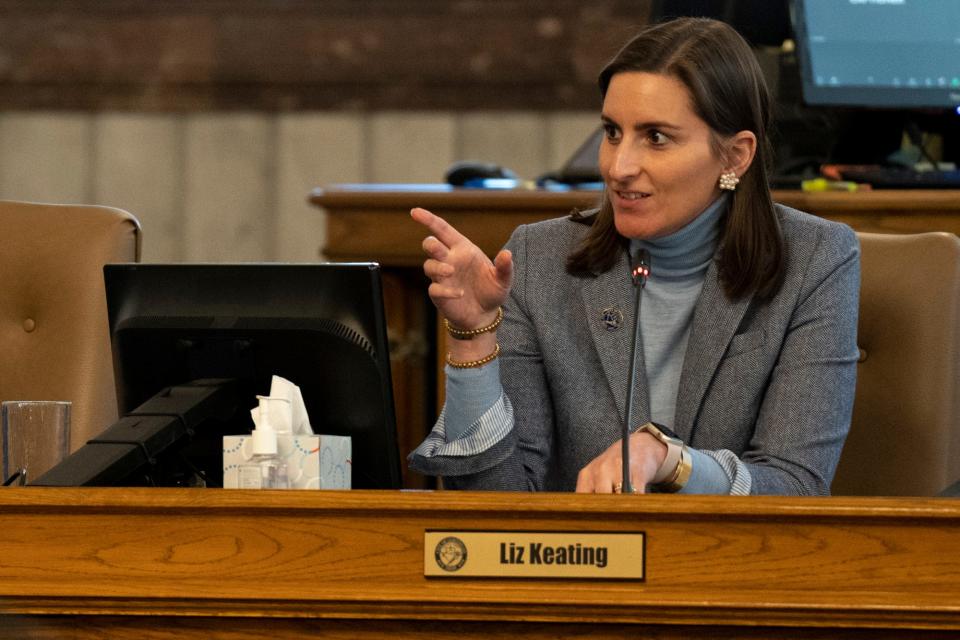Abortion access, railroad sale, marijuana among big election winners in Ohio, Kentucky | Opinion
- Oops!Something went wrong.Please try again later.
- Oops!Something went wrong.Please try again later.
- Oops!Something went wrong.Please try again later.
Some quick takes on the winners, losers and other highlights from Tuesday’s elections in Ohio and Kentucky:
WINNER: Allowing women, doctors to make reproductive decisions

Voter approval of a constitutional amendment ensuring abortion rights in Ohio takes reproductive decisions out of the Statehouse and into medical professionals’ offices where they belong.
Abortions will be allowed until the time a doctor determines the fetus would be viable outside the womb, around 22-24 weeks. After that, only if the doctor determines it is needed to protect the woman’s life and health.
Passage of Issue 1 stops the return of the Legislature-passed "Heartbeat Law" Gov. Mike DeWine signed in 2019. Blocked by a Hamilton County judge’s order pending outcome of state appeal, it bans abortions after about six weeks − when many women don’t know they’re pregnant yet − without exceptions for rape, incest or deadly fetal defects.
The new law of the state helps relieve doctors of legal uncertainty about making what they believe are the right medical decisions for their female patients.
Ohio was the only state with an abortion ballot measure this November, and Issue 1’s passage makes it the seventh state, of seven voting, to vote in favor of abortion rights or against anti-abortion measures since Roe v. Wade was overturned by the U.S. Supreme Court last year.
LOSER: A sneaky, misleading campaign

With the poll numbers against them on abortion, Ohio Republicans first tried to move the goalposts with an Aug. 8 special vote to raise the threshold for such constitutional amendments from a simple majority to 60% − just above the polls in favor of abortion rights.
Voters saw through it, shooting down that Issue 1 with a 57% "No" vote.
Then they had to vote "Yes" on Tuesday’s Issue 1 to support abortion access, while peering through a veil of misleading claims such as that Issue 1 would lead to late-term abortions, "up to the moment of birth."
Federal statistics for 2020, when Roe v. Wade legal abortion protections still in effect, showed 93% of abortions occurred before 13 weeks, and less than 1% occurred after 21 weeks.
The Republican-controlled ballot board led by Secretary of State Frank LaRose put language on the ballot that Issue 1 "would always allow an unborn child to be aborted at any stage of pregnancy regardless of viability." That’s a campaign message, not a statement of fact.
There were also false claims during the campaign that Issue 1 would allow "partial-birth abortions," which are banned by federal law.
There also were unsubstantiated claims that the issue would take away parental rights not only on abortion but on gender surgery.
Issue 1 opponents seemed to forget − and hoped Ohioans would − about the "Heartbeat Law" that was pending in court.
Among many unfavorable analyses and fact checks about anti-Issue 1 tactics was by the global news organization The Associated Press,’ which found "Misinformation is rampant ahead of Ohio vote on abortion rights."
WINNER: Democrat re-elected in red-state Kentucky

Gov. Andy Beshear’s reelection in Kentucky shows again that a Democrat can win a red state − just as Gov. Laura Kelly did in Kansas − on a solid record and personal favorability, even when President Joe Biden’s low poll standings threaten to drag them down.
Beshear, 45, won Tuesday three years after Republican President Donald Trump beat Biden by 26 percentage points to carry Kentucky a second time. His opponent, Attorney General Daniel Cameron, featured Trump’s endorsement in the campaign’s final weeks while trying to tie Beshear to Biden.
Beshear reelected Kentucky governor: 'A pragmatist who gets results': How Beshear won NKY again
Beshear’s campaign highlighted Cameron’s anti-abortion views in a state where voters rejected an anti-abortion measure last year. He also ran on a record of economic development, low unemployment, and steady, responsive leadership through tornado, flooding and pandemic emergencies.
Look for Beshear’s name to show up when political pundits start speculating on potential Democratic presidential candidates.
HIGHLIGHT: Cameron’s defeat doesn’t close future doors

At 37, the first Black major-party nominee for governor in Kentucky remains a Republican star after falling short to an incumbent governor whose father also served two terms as governor. It was a spirited campaign and Cameron nearly closed polling gaps in the final weeks.
Cameron served as legal counsel in the U.S. Senate to then-Majority Leader Mitch McConnell. He could be McConnell’s heir-apparent, if and when McConnell decides to retire.
LOSER: Catholic funding in political issues

Cincinnati Archbishop Dennis Schnurr acknowledged in August that some oppose the Catholic Church being involved in politics, but he issued a "letter to the faithful" saying the abortion vote "compels our participation in this critical moral issue.”
The Cincinnati diocese, other Ohio dioceses and the Catholic-affiliated Knights of Columbus fraternal organization contributed a total of more than $2 million to trying to defeat Issue 1.
Which makes me think of the words of the high priest in "Jesus Christ Superstar:" "Think of the things you could do (could have done) with that money; choose any charity, give to the poor."
WINNER: Cincinnati Mayor Pureval on Issue 22

Democratic Mayor Aftab Pureval was the face of the Cincinnati campaign for voter approval of the planned $1.6 billion sale of the city’s railway to Norfolk Southern. Pureval contended that investing the proceeds would produce an annual flow of income well above the current lease agreement, money that could help address infrastructure needs.
Increasingly vocal opposition to "Save Our Rail" and "Derail The Sale" challenged the wisdom of giving up a reliable revenue-producing asset that dates to the 19th century, whether the city was getting a good price, and expressed mistrust about the motives of Pureval and other sale backers.
Pureval has said the railway sale is among "big swings" he’s taking for the city’s future, and a defeat would have been an early and pivotal swing and miss in those plans for the mayor who says he will seek a second four-year term in 2025.
Issue 22 analysis: The 3 reasons Cincinnatians voted to sell their railroad
HIGHLIGHT: Grassroots campaign rallied rail sale opposition against the odds

Those opposed to the railway sale waged a David-and-Goliath battle, outspent at a rate of something like $1,000 to 1 by Norfolk Southern Corp. But they tirelessly worked social media, wrote op-eds and letters to the editor, held rallies, and maybe at least gave the railway backers a scare.
It will be interesting to see if that energy can be transferred to other local causes and campaigns.
LOSER: Republican representation on City Council

By most accounts, Republican Liz Keating worked hard and enthusiastically to build bridges and legislate collegially with the other eight Cincinnati council members, all Democrats, while offering a moderate Republican voice.
Yet, with only 10 candidates on Tuesday’s ballot, she ran 10th, leaving the city with one-party rule. That’s usually not a good idea anywhere, be it in Washington, Statehouses, or in municipalities.
The granddaughter of the late Enquirer publisher and former congressman William J. Keating might have other political alternatives in her future, but for now, it’s important for city officials to try to listen to voices outside the dominant Democrats.
WINNER: Academic freedom in an Eastern Hamilton County district

Forest Hills Schools, which covers Anderson Township and the Village of Newtown east of Cincinnati, elected two new school board members in a district that’s been roiled by controversies.
Educators Wendy Strickler Biederman and Jason Simmons say they want to get the school board refocused on education and away from culture wars that have caused often-raucous board meetings.
A Republican-backed slate of four candidates in 2021 has been followed by cancellation of a high school’s annual Racial Diversity Day, then passage of a "Culture of Kindness" resolution that restricted teaching on topics including race, gender, sexual orientation, gender identity, religion and socioeconomic class.
A middle school mural celebrating diversity was painted over this school year.
The winning candidates say they want to make sure all students know that they belong and that their voices matter.
WINNER: Fans of marijuana

Passage of Issue 2 will legalize recreational marijuana across the state. Ohio already had legalized medicinal marijuana. Proponents of Issue 2 said the state will reap millions in tax revenues, and stop losing sales to Michigan where pot is legal.
Opponents warn of crime issues, more marijuana reaching underage users, and unsafe, impaired driving increasing.
Law enforcement resources are probably better focused on the spread of deadly fentanyl than use of marijuana, which probably will be mostly consumed in homes, perhaps with Pink Floyd playing in the background.
Dan Sewell is a regular Enquirer Opinion contributor. Contact him at his personal email dsewellrojos@gmail.com.
This article originally appeared on Cincinnati Enquirer: Ohio, KY election: Issue 1, Beshear win; sneaky GOP campaign loses

